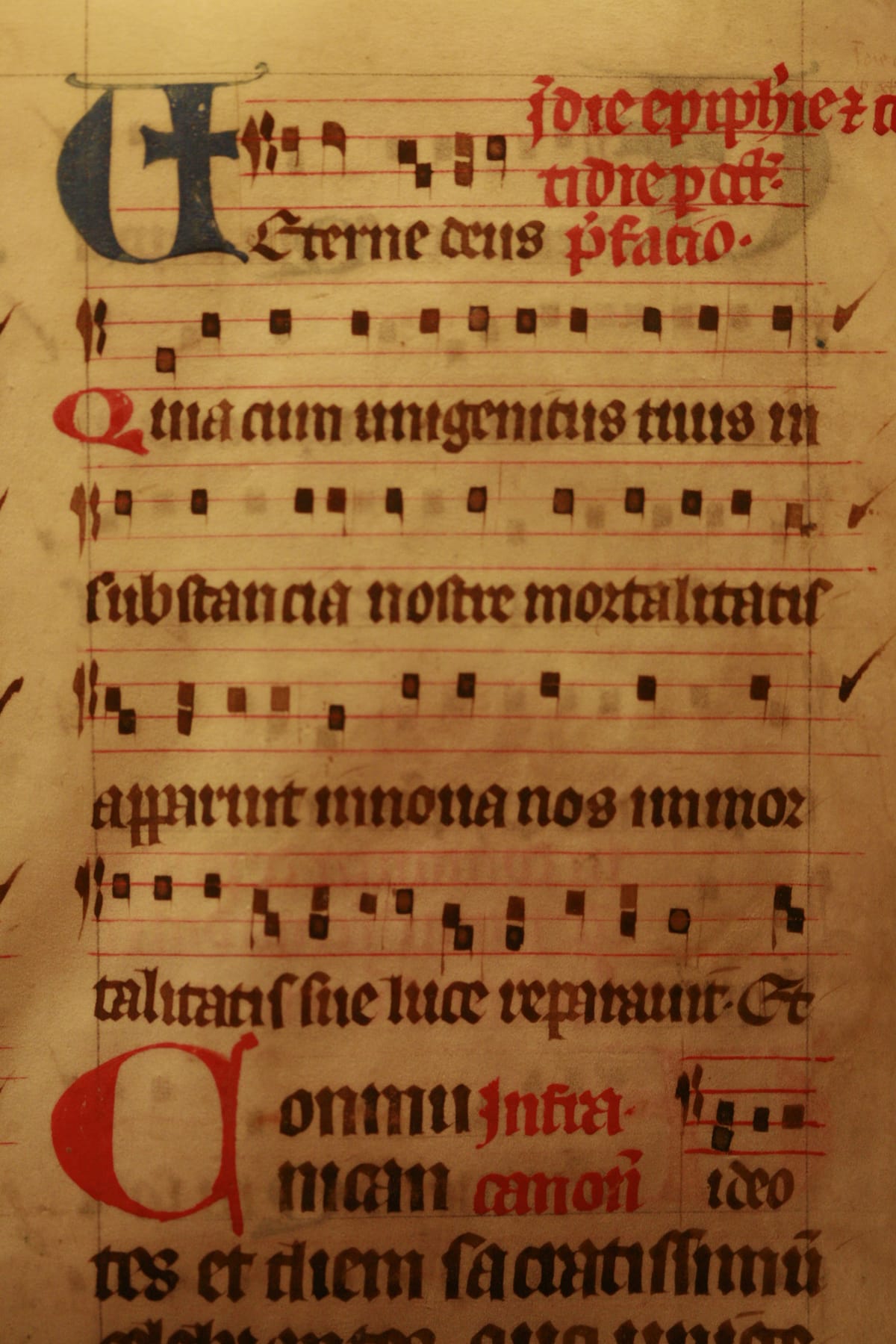Music Literacy – It’s Greek to Me

Western Classical music education is a brand name used for parts of the pedagogy of music literacy.
Music literacy, as used today, was born out of a finite notation system using neumes[1]. This notation was necessary for the rise of the Christian Church and plainchant – a simple liturgical melody that followed sacred and secular days – was created after the fall of the Roman Empire and was attributed to Pope Gregory (AD540-604). However, it was the Frankish monks of the 9th century that appeared to have solidified and codified the notational systems set forth in the 6th and 7th centuries therefore calling them Gregorian chants. The creation of this system allowed for the preservation of plainchants and a uniformity of music that was to be sung, mainly acapella (without accompaniment). The staff system (made of 4 lines instead of the 5 used today) had the first clef (key), which was the viola, alto or later known as the “C” clef.
This clef was movable on any of the lines and spaces – at that time only using four lines and three spaces. Wherever this clef was placed was the Tonic, or the main tone from which the Priest, Monk or other would commence. These neumes were of varied value, similar to notated rhythms and would adhere, loosely, to a meter, or measured time/beat. Their values, derived from Greek musical thought, were intended for value of the pitches in measured precision, as was the value, and the spaces between.[2] The current notation system we use today has expanded to five lines, four spaces, and a simple pattern of notation and finite pitches, currently reserved to the range of a piano, or covering all of the low to high instruments of an orchestra or choir known as the Grand Staff. The scales were from a Greek pitch system called Modes. The modes had various scales and constructions and had to be mathematically precise, using physics to determine pitching “For Pythagoras and his followers, numbers were the key to the universe and music was inseparable from numbers.” (Hanning, page 22) Greek Philosophers said of music “music is necessary to develop a person as a whole”. (M. Boyahzhieva, AES). Renaissance priests and philosophers, such as Marsilio Ficino, a Platonist philosopher said this of Music: “Plato and Aristotle taught, as we have often found from our own experience, that serious music maintains and restores this harmony to the parts of the soul, while medicine restores harmony to the parts of the body.”[3]
Today, taken from Greek precision of science and mathematics via their Modes, or Scales, we use the Ionian Mode for our Major scales, and Aeolian for the Natural minor scale. Each scale is constructed by whole tones (diatonic) or semi tones (chromatic). Continuing with the precision of the Perfect 5th and the Circle of 5ths the harps or Lyres would be tuned accordingly, with the Perfect 4th as the additional tuning for instruments with six strings. A Perfect 5th is five diatonic notes apart and a perfect fourth is four diatonic notes. Every Major scale maintains a Perfect unison, 4th and 5th. This is important for construction of chord harmony building from a root tone, with a fourth or fifth tone above. Pythagoras discovered the octave, 4th and 5th generated by simple ratios based on the vibrating ratios of the lengths of strings. The Perfect 5th, and the Perfect 4th – all tuning from the Greek Modes and their constructions, are the foundations of current “Western” Music notation and harmonic construct.
However, Western Classical Music does not define music literacy. Music literacy, through the notational systems created during the time of Plato and Pythagorus, evolved into the notation system we use today. It is a “pitch” alphabet that is mathematically measured by subdivisions of time value, using inflections that are called articulations, paired with expression, or how we phrase, breathe and cadence, emotionally, the music that is being performed. This notation system allows you to (approximately) notate music from around the world, imitate birds after a rain, or the rain itself, or demonstrate the feelings of the heart. It is an accessible and easy to learn “alphabet”. (M. Boyadzhieva, AES)
Music Literacy means the understanding and use of this notation system applied to ANY music in the world, pitched or un-pitched. It allows us to create and identify musical elements that we hear, collectively, in music: Melody, Meter, Rhythm, Tempo, Harmony, Dynamics, Style and Context. Western Classical musicians and composers were not the creators of Western Classical music literacy. They looked backwards in order to move forwards in the evolution of creating, performing and expanding every elemental concept of music, either as Absolute Music (Music for Music’s sake, often seen in Mozart and Haydn Symphonies) or to use it as part of a necessary diverse human expression, highlighting societal, historical, emotional or other contextual reasons for the creation of a specific piece of music such as could be found in Beethoven’s Eroica Symphony.
https://www.youtube.com/watch?v=InxT4S6wQf4
Learning music, especially with an instrument, using a notation system, unifies cognitive, social and emotional understanding that is constantly using language, mathematical and scientific concepts such as physics, collaboration, empathy, analysis and physical development in a simultaneous split second anticipation before the first note is played, and maintained throughout a piece of music. This is the brilliant brain on music, through music literacy.
Being literate in “Western” music doesn’t mean imitating a song only for special occasions. Being literate in music ensures that music learners have a strong foundation in the literacy, the elements, and skills based learning development necessary to grow and succeed in music learning, and hone their skills in other subjects as well. Americans for the Arts, in their publication, The Arts Index, An Annual Measurement of the Vitality of Arts and Culture in the United States stated that only 17% of High School Seniors (US) stay in music their entire four years of high school. And of those 17% that do, they score, on average, an additional 100 points on their SAT scores. This is easy math to see why students should remain in music, as literate musicians and performers throughout primary and secondary school.
Now comes the hard part, the very literate and talented musician, what is their future? More careers than ever are opening up in the arts fields. Entertainment alone in the US earns over $180 billion per year. There is no subject that offers the whole person learning, such as music does. (M. Boyadzhieva, AES) Also, an instrument never leaves you, never cheats on you, and is joy and solace throughout your life, played or sung. Just being a literate appreciator of music adds to the depth of understanding of music, and other topics.
Why “Western” music literacy? Smart, happy, talented and creative people with split second analytical skills that every company, in the arts or not, wants to employ. Is it worthwhile to be literate in music? You do the math.
- Neumes definition and use. https://en.wikipedia.org/wiki/Neume#Use_in_Western_plainchant ↑
- Barbara Russano Hanning. Concise History of Western Music, Third Edition, Chapter 1, Greek Music Theory, Music in Ancient Greece and Early Christian Rome. Norton, New York 2006 ↑
- Ficino, Marsilio. The Letters of Marsilio Ficino, Volume 1. Translated from the Latin by members of the Language Department of the School of Economic Science, London. Shepheard-Walwyn, 1975 ↑





